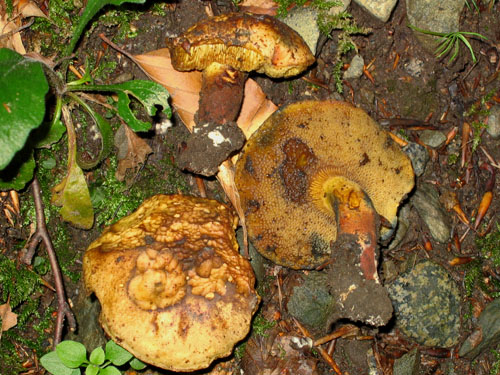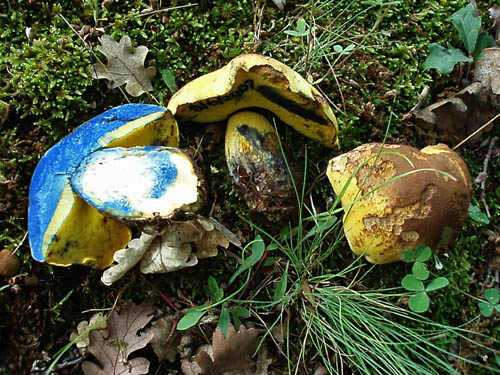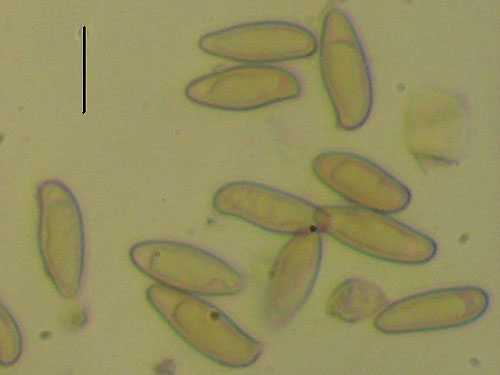Boletus L.
Recent molecular studies have shown that Boletus in its current circumscription is likely an artificial grouping and it is possible that it will be split at some point into smaller genera. Note that Boletus impolitus and Boletus depilatus for practical reasons are retained here, although there is strong evidence that they are closely related to Xerocomus subtomentosus and its allies.
Fruitbody large to medium sized, boletoid, without veil and ring. Stipe solid, with surface usually covered with granules or network. Flesh variously coloured, changing or not when exposed to air. Tubes easily separable from each other, not tearing apart. Pores usually small and rounded.
Boletus pulverulentus Opat.
Description
Pileus up to 8 cm, convex, flat-convex to almost flat, velvety to smooth or slightly viscid, yellow, yellowish ochraceous, ochraceous light brown, brown, olivaceous brown, orange brown or red, blueing when bruised. Stipe usually cylindrical, tapering or spindle-shaped, at least in the upper part yellow or yellowish, towards the base greyish, brownish or reddish to vinaceous, strongly blueing and then blackening when bruised. Flesh pale yellow, strongly blueing after exposure to air. Tubes pale yellow to yellow with olivaceous tint, strongly blueing. Pores medium sized, angular, concolorous with the tubes, strongly blueing when bruised. Smell not distinctive. Taste acid. Spores 11–16 × 4–5.5 μm. Pileipellis (the cap cuticle) a palisadoderm, composed of hyphae of cylindrical finely incrusted cells. Chemical reactions: hyphae of the flesh in the stipe base inamyloid with Melzer’s reagent.
Habitat. Broadleaf or mixed forests, parkland and gardens, mycorrhizal with oaks (Quercus), beech (Fagus), sweet chestnut (Castanea sativa), lime (Tilia) and probably other broadleaf trees.
Distribution. Widespread throughout Europe.
Note. Variable species, but generally recognized by its gracile, xerocomoid stature, medium sized, angular pores, and strongly blueing flesh.
Photographs

Fruitbodies of Boletus pulverulentus. Note the small size and the xerocomoid appearance. (photo B. Assyov)

Fruitbodies of Boletus pulverulentus. Note the violent blueing. (photo G. Konstantinidis)

Boletus pulverulentus. Note the intense blueing of the stipe and the pores. (photo B. Assyov)

Boletus pulverulentus - spores. Scale bar = 10 μm. (photo B. Assyov)
Important literature
Alessio, C.L. 1985. Boletus Dill. ex L. (sensu lato). – In: Fungi Europaei. Vol. 2. Pp. 1–705. Libreria editrice Biella Giovanna, Saronno.
Breitenbach J. & Kränzlin F. 1991. Pilze der Schweiz. Bd. 3(1). Röhrlinge und Blätterpilze. Verlag Mykologia, Luzern.
Engel, H., Krieglsteiner, G., Dermek, A. & Watling, R. 1983. Dickröhrlinge. Die Gattung Boletus in Europa. Verlag Heinz Engel, Weidhausen b. Coburg.
Estadès, A. & Lannoy, G. 2004. Les bolets européens. – Bulletin Mycologique et Botanique Dauphiné-Savoie 44(3): 3–79.
Galli, R. 1998. I Boleti. Atlante pratico-monographico per la determinazione dei boleti. Edinatura, Milano.
Hansen, L. & Knudsen, H. 1992. Nordic Macromycetes. Vol. 2. Polyporales, Boletales, Agaricales, Russulales. Nordsvamp, Copenhagen.
Knudsen, H. & Vesterholt, J. [eds.]. 2008. Funga Nordica. Nordsvamp, Kopenhagen.
Lannoy, G. & Estadès, A. 2001. Les Bolets. Flore mycologique d’Europe. Documents Mycologiques Mémoire Hors série no. 6. Pp. 1–163. Association d’Écologie et de Mycologie, Lille.
Muñoz, J.A. 2005. Boletus s. l. – In: Fungi Europaei. Vol. 1. Pp. 1–951. Edizioni Candusso, Alassio.
Pilát, A. & Dermek, A. 1974. Hríbovité huby. Československé hríbovité a sliziakovité huby (Boletaceae – Gomphidiaceae). Veda, Bratislava.
Singer, R. 1967. Die Röhrlinge. II. Die Boletoideae und Strobilomycetaceae. – In: Die Pilze Mitteleuropas. Vol. 6. Pp. 1–151. Julius Klinkhardt Verlag, Bad Heilbrunn.
Šutara, J., Mikšík, M. & Janda, V. 2009. Hřibovité houby. Čeled’ Boletaceae a rody Gyrodon, Gyroporus, Boletinus a Suillus. Academia, Praha.
Watling, R. 1970. Boletaceae, Gomphidiaceae, Paxillaceae. – In: Henderson, D.M., Orton, P.D. & Watling, R. [eds]. British fungus flora. Agarics and Boleti. Vol. 1. Royal Botanic Garden, Edinburgh.
Watling, R. & Hills, A.E. 2005. Boletes and their allies (revised and enlarged edition). – In: Henderson, D.M., Orton, P.D. & Watling, R. [eds]. British Fungus Flora. Agarics and boleti. Vol. 1. Royal Botanic Garden, Edinburgh.